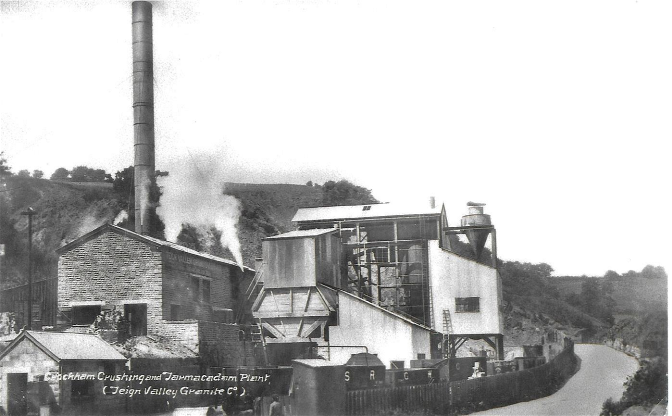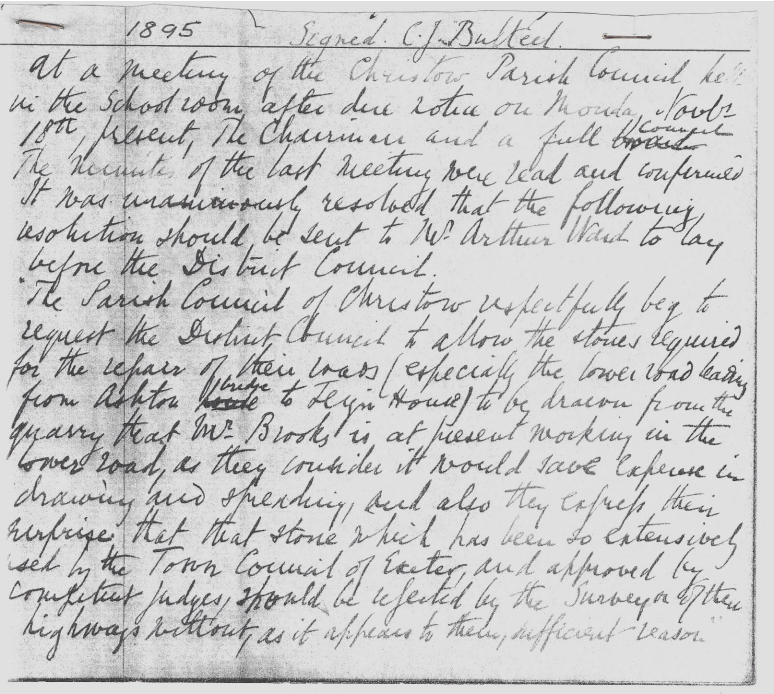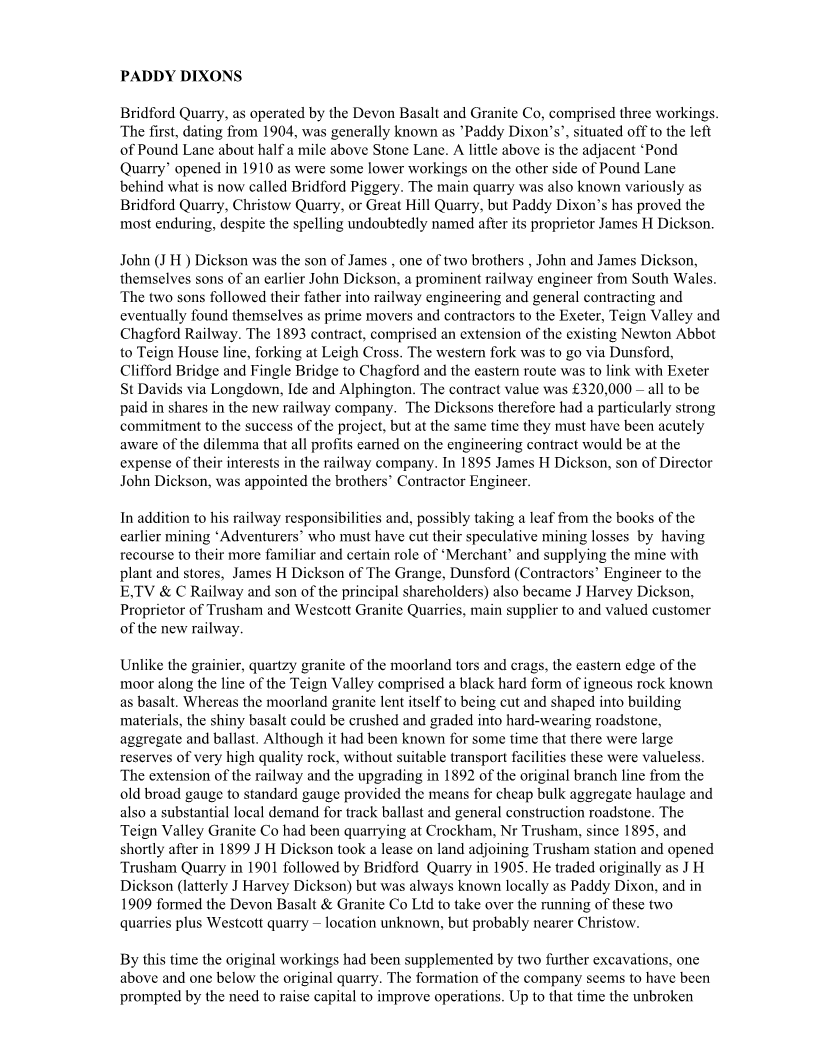Geology, mines and quarries - page 7
There is plentiful evidence for the industrial scale of the extraction of the Teign Valley’s hardest and least yielding rocks which were crushed into different fractions for aggregates - railway ballast, road stone, concrete manufacture and so on.

All but one of the quarries concerned were on the bands of igneous dolerite that interleave the valley’s chert and shales. This is known to quarrymen as greenstone, though its actual colour is usually grey or brownish. The exception is Scatter Rock with its basalt of volcanic origin made even harder by the metamorphic effect of the granite intrusion - the stone known locally as woodstone or blue elvan.
Crockham
As you head down the valley and turn left into the double bend where the lane to Teign Village goes off to the right it’s not obvious that the steep wooded bank in front of you marks the side of a hill that has been hollowed out to below the level of the river. Crockham is the greatest and longest-lived of the local quarries. It’s in Hennock parish but is often called Trusham Quarry, perhaps because its output was forwarded from Trusham station. It was opened in 1895 and at one time employed over 100 men until increasing mechanisation allowed for a reduction in the labour force.

The quarry company built Teign Village around 1912 for their accommodation. It remained active until 2004 when it was mothballed by Hanson’s, the latest of its several owners. A recent appraisal of the amount of usable stone remaining had seemed to guarantee its future, but the quality of what was being extracted was deteriorating. There was also a coated stone (‘tarmac’) plant on site, active until 2013. Even before the quarry closure this had needed to use more suitable stone from Hingston Down in east Cornwall as well as from north Devon, while the sand was trucked in from Wareham in Dorset. Along with the associated pre-cast concrete works which used the finer fractions of the crushed stone (and which was an invaluable local source for pipes, gulley traps, cistern rings etc.), it was the greatest single employer in the valley for the whole of the twentieth century – latterly forty employees on the quarry side and more than a hundred in the concrete works. Until the mid-1990s, when the pre-cast part of the operation shut, the B 3193 passed through the centre of the company’s facilities with the sheds and yards of the concrete works on one side and the crushers, hoppers and so on of the quarry on the other. Opened in 1996 the newly aligned road has obliterated all traces of the former that haven’t been taken up by the coachbuilders. As for the latter - no more do we sometimes hear (on a still day) the muffled boom of the midday rock-blasting down the valley.
Ryecroft
Across the Teign from Crockham is Old Trusham Quarry, known also as Paddy Dixon’s, which opened in 1899. Less than half a mile upriver are Tinkley and Whetcombe quarries, both closed in 1931. Two miles north and again just east of the river is Ryecroft which was opened as a family business in 1930 but the generally poor quality of the stone and the depth of overburden led to its closure early in the Second World War and a final winding-up in 1953. This makes it especially curious that an apparent attempt was made to re-open it in 2000, the original licence that allowed the quarry to operate being still valid. The company formed for this venture claimed that sufficient stone of value remained in the waste heaps to obviate the need for fresh excavations. Amidst growing controversy some expensive machinery was assembled on site. The Teign Valley Action Group sprang up to contest this reworking, claiming – among other things – that lorry movements would be a hazard to mothers with young children, though it is rare to see anyone (with or without children) walking along the stretch of road in question. A fault line developed between those local inhabitants who wanted to preserve their peace and quiet and those that looked forward to some employment opportunities and a handy source of aggregates. The TVAG took the matter to the High Court where the judge ordered Devon County Council to review their upholding of the licence. In 2003 the enquiry inspector decided in favour of renewed working, but this decision was overturned by a vote of councillors and the licence rescinded. At the time of writing the road signs warning of heavy vehicle movements are still in place, though those movements never came to pass.
Brooks Quarry
This was in operation in the late 19th century and seems mainly to have supplied an indifferent roadstone. It’s the other quarry which is visible right beside the valley road a little below the bridge into Ryecroft Quarry. Stafford Clark quotes a Christow Parish Council resolution (November 18th, 1895) to be laid before the district council, requesting that the PC be allowed to use stone from here for road repairs – it having been rejected by the surveyor of highways.

The council drew attention to the fact that this same stone had been “extensively used by the Town Council of Exeter and approved by competent judges”. Whatever the outcome, and a refusal seems likely, the quarry probably closed soon after this date in the face of competition from the superior Trusham stone.
Bridford Quarry
This was opened in 1905 by the same JH Dickson who was the proprietor of Old Trusham Quarry and it too was sometimes known as Paddy Dixon’s. It lies on either side of Pound Lane beside and above the bend on the steep part of the hill. From the start it was able to take advantage of the newly opened Christow Station, at first by carting the stone along the road to the station where it was crushed. Production increased markedly from 1910 under the new ownership of Devon Basalt and Granite Ltd. This company constructed a direct link between the quarry and the Teign Valley line. Stone from the two pits to the north of the road was conveyed on a narrow-gauge railway which crossed the highway to the third pit. From here a rope-worked incline led to crushers 300 ft./100 m. below on the north bank of the Rookery Brook right next to the barytes mine. This was the terminus of a standard gauge track that followed the course of the brook, crossing the valley road on the level and taking the stone across the river into Christow Station, three-quarter of a mile distant. The incline passed under Stone Lane – the bridge is still there, recently rebuilt by Devon County Council at some expense. Part of the railway’s embankment as it approaches the river crossing is visible from the short footpath leading from the valley road, just north of the Teign House, to the footbridge that crosses the Teign to the station. Piers that supported its bridge are still to be seen on either bank.

The fortunes of Bridford Quarry declined as those of the nearby Scatter Rock increased and it closed in or around 1927. In 1930 the track beside the brook was leased to the barytes mine which by this time was finding the cart-track access to the station unequal to the amounts of mineral now being raised under the new Malehurst ownership. For a variety of possible reasons, it was decided to replace the private railway with a road. This is still private. It leads up from the vet’s surgery and now gives access to three dwellings – one that started life as a bunkhouse for the mine and two at its top end on the site of the mine and the rail terminus.